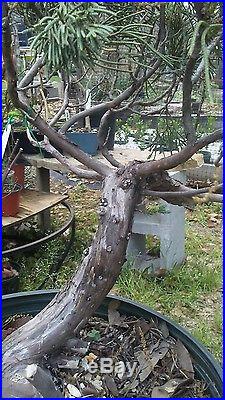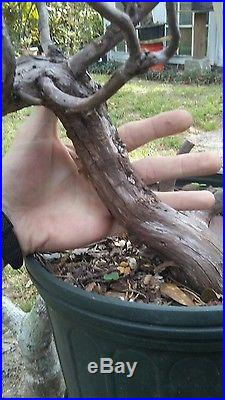


An old specimen ready to be shaped. The trunk is a few inches thick as you can see in the pics. Its been in this pot for two years now. It has lots of little healthy shoots on it. Ill be revising the listing later. Heres a little about the juniper in general. The juniper is a genus of about 50 – 70 species within the cypress family. They are evergreen coniferous trees or shrubs, which are very popular for Bonsai purposes. The most popular species are the Chinese juniper (Juniperus chinensis), the Japanese Shimpaku (Juniperus sargentii), the Japanese needle juniper (Juniperus rigida), the two central European species: the savin (Juniperus sabina) and the common juniper (Juniperus communis), and other species and cultivars from many parts of the world which are available in our nurseries. The foliage colors range from dark blue-greens to light greens and the foliage can either be scale-like or needle-like. Scale junipers usually have needle-like foliage when they are young (called juvenile foliage), the typical scale-like foliage appears later. After heavy pruning or bending, over-watering or other stress often juvenile foliage will grow again. It can last a few years until enough normal scale-like foliage has grown and all the needle-like foliage can be removed. The berry-like cones are round or oval, depending on the species they measure between 3 mm and 2 cm and they need a year or two to ripen. The seeds are round or edged. The cones are often eaten by birds who spread the germinal seeds later with their droppings. Junipers are very suitable for creating deadwood (jin and shari). This is due to the fact that live veins below a broken or for other reasons dying branch will dry out and die. This results in natural deadwood which is peeled, polished and bleached by climatic conditions and is very durable in case of the juniper. The triad of green foliage, reddish-brown or yellowish-brown bark and silvery white deadwood is very appealing. Specific Bonsai care guidelines for the Juniper Bonsai Position: Place the tree outside, year-round, on a bright spot with lots of sunlight. The Juniper cannot live indoors. During the winter protect the tree once temperatures drop below -10 degrees C (14F). Some species change their foliage color during frosty periods to a purplish brown which is connected with their frost protection mechanism. In spring they will turn green again. Watering: Be careful not to water too much, as the juniper roots don’t like soil wetness. Before you water, the soil should dry well. Misting the tree can be done regularly, especially after the tree has been repotted because it benefits from air humidity. Continue reading about watering Bonsai trees. Feeding: Use normal organic fertilizer pellets or balls every month during the growth season or a liquid fertilizer each week. If strong growth is desired some higher nitrogen levels can be applied in spring. Pruning: To develop the foliage pads, long shoots which stick out of the silhouette can be pinched or cut at the base with sharp scissors throughout the growth season. Do not trim the juniper like a hedge because the removal of all growing tips will weaken the tree and the cut will turn the needles brown. When the foliage pads become too dense they must be thinned out with sharp scissors at the base. The Juniper Bonsai is generally a strong tree that also withstands aggressive pruning quite well. But it cannot bud again from bare tree parts, so take care that there is some foliage left on every branch you want to keep alive. Continue reading about pruning Bonsai trees. Wiring: Junipers which are produced for Bonsai purposes are already wired quite heavily in most cases when they are still very young. Dramatically twisted shapes are very popular and correspond with the natural shapes that used to grow in the Japanese mountains in former times. Junipers can be strongly bent, if necessary wrapped with raffia or tape as a protection, but you must be careful with parts which possess deadwood. Those parts break easily. If they are large and old, you can split the deadwood off in order to bend the more flexible living parts. The foliage pads should be wired and fanned out after thinning when necessary, to let light and air get in. Otherwise the inner parts of the foliage pads will die. In addition to this, the danger of pest infestation is increased if the pads are too dense. From the aesthetic point of view we also want to achieve unobstructed structures and want to prevent the juniper from looking like broccoli. Repotting: Once every two years, very old trees at longer intervals, using a basic (or somewhat more draining) soil mixture. Don’t prune the roots too aggressively. Propagation: Use seeds or cuttings. Acquisition of juniper Bonsai: Many well-suited juniper species in different sizes are offered in most nurseries. You can often find good Bonsai raw material there. Specialized Bonsai traders offer everything from young plants, pre-Bonsai and pre-styled juniper trees up to high-value Bonsai, in various styles and shapes. Pests / diseases: If junipers are well cared for and placed in an ideal position they are quite resistant against pests. It is important though not to let the foliage pads get too dense, because otherwise pests can settle in them more easily. During winter the junipers must be kept in a place with enough light and they must be checked for pests regularly because pests can even occur in winter. Junipers can sometimes get infested with spider mites, juniper scale, juniper aphids and juniper needle miners as well as juniper web worms for example. Customary insecticide / miticide sprays will help but you should also find the reason why the tree was prone to infestation. A big problem are fungal rust diseases. The diverse juniper species and cultivars have a very different level susceptibility to rust fungus, there are also some which are regarded as resistant. As a rule of thumb, the blue-green junipers are more resistant than those with yellowish-green foliage. The Japanese junipers are also not infested very often. In the internet you can find files which list many juniper species and cultivars and their susceptibility / resistance level to rust fungus. The rust fungus infests the junipers permanently and causes swellings from which hard, brown galls emerge. In spring, during rainy weather, the galls produce large, orange, gelatin-like tendrils, full of spores, which infest the leaves of pear trees (but there are also types of rust fungus which use hawthorn or crab apples as a second host instead of the pear). The fungus causes orange spots on the pear leaves. In late summer brownish proliferations grow from the bottom-sides of the leaves which release spores that infest junipers again. While the pear trees in most cases are not fatally affected they are newly infested each year again and they can even be treated successfully with a fungicide, an infested juniper normally cannot be cured. The visibly infested branches die in most cases and the fungus can emerge on other tree parts. Removing the parts with the swellings and galls is no guarantee at all that the fungus will not reappear. Although some people have a different opinion, it is best to immediately burn up a rust-infested juniper or put it into the garbage instead of your compost heap. The item “Old juniper pre-bonsai tree” is in sale since Sunday, March 26, 2017. This item is in the category “Home & Garden\Yard, Garden & Outdoor Living\Plants, Seeds & Bulbs\Plants & Seedlings\Bonsai”. The seller is “odarkwave_7″ and is located in Mobile, Alabama. This item can be shipped to United States.
- Type: Conifer
- Bonsai Species: Juniper Bonsai (Juniperus)
- Indoor/Outdoor: Outdoor
- Plant Form: Pre-Bonsai
- Watering: Light
Tags: juniper, pre bonsai, tree





















0